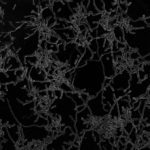Lien vers Pubmed [PMID] – 26220968
Lien DOI – 10.1128/mBio.00986-15e00986-15
mBio 2015 Jul; 6(4): e00986
The fungal cell wall confers cell morphology and protection against environmental insults. For fungal pathogens, the cell wall is a key immunological modulator and an ideal therapeutic target. Yeast cell walls possess an inner matrix of interlinked β-glucan and chitin that is thought to provide tensile strength and rigidity. Yeast cells remodel their walls over time in response to environmental change, a process controlled by evolutionarily conserved stress (Hog1) and cell integrity (Mkc1, Cek1) signaling pathways. These mitogen-activated protein kinase (MAPK) pathways modulate cell wall gene expression, leading to the construction of a new, modified cell wall. We show that the cell wall is not rigid but elastic, displaying rapid structural realignments that impact survival following osmotic shock. Lactate-grown Candida albicans cells are more resistant to hyperosmotic shock than glucose-grown cells. We show that this elevated resistance is not dependent on Hog1 or Mkc1 signaling and that most cell death occurs within 10 min of osmotic shock. Sudden decreases in cell volume drive rapid increases in cell wall thickness. The elevated stress resistance of lactate-grown cells correlates with reduced cell wall elasticity, reflected in slower changes in cell volume following hyperosmotic shock. The cell wall elasticity of lactate-grown cells is increased by a triple mutation that inactivates the Crh family of cell wall cross-linking enzymes, leading to increased sensitivity to hyperosmotic shock. Overexpressing Crh family members in glucose-grown cells reduces cell wall elasticity, providing partial protection against hyperosmotic shock. These changes correlate with structural realignment of the cell wall and with the ability of cells to withstand osmotic shock.The C. albicans cell wall is the first line of defense against external insults, the site of immune recognition by the host, and an attractive target for antifungal therapy. Its tensile strength is conferred by a network of cell wall polysaccharides, which are remodeled in response to growth conditions and environmental stress. However, little is known about how cell wall elasticity is regulated and how it affects adaptation to stresses such as sudden changes in osmolarity. We show that elasticity is critical for survival under conditions of osmotic shock, before stress signaling pathways have time to induce gene expression and drive glycerol accumulation. Critical cell wall remodeling enzymes control cell wall flexibility, and its regulation is strongly dependent on host nutritional inputs. We also demonstrate an entirely new level of cell wall dynamism, where significant architectural changes and structural realignment occur within seconds of an osmotic shock.

